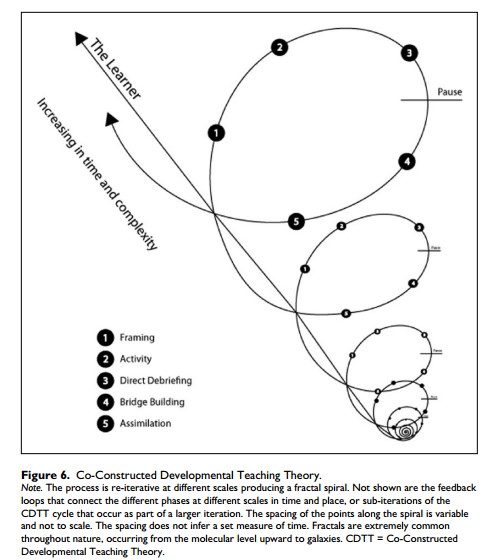Schenck & Cruickshank (2015) re-conceptualize experiential learning to accommodate how students learn biologically. Their Co-Constructed Developmental Teaching Theory (CDTT) provides a testable framework for teachers and facilitators to use when designed experiential learning activities and the associated critical reflection assignments. Like the DEAL model, CDTT emphasizes the importance of identifying explicit learning goals of the EL activity. Creating activities, critical reflection, and assimilation opportunities around these learning goals will maximize the efficiency and productivity of the student’s learning.
The CDTT model (see Diagram 3) is built on a fractal structure, where a student’s learning at different times and over different activities interact in a series of feedback loops. Each learning activity would ideally follow the CDTT cycle of Framing, Activity, Direct Debriefing, Bridge Building, and Assimilation. The authors also recommend building in pauses between the 3rd and 4th and 4th and 5th stages to allow a student’s brain the necessary downtime for optimal learning.
Diagram 3
(Schenck & Cruickshank, 2015)
The CDTT model focuses on the teaching process, rather than Kolb’s model of the learning process, providing teachers with guidance at each stage of the CDTT cycle.
1. Framing: Learners need an explicit goal in mind for optimal learning. Neuroscience research shows that the human mind is goal-oriented. When students know what they are expected to learn they are more likely to stay engaged in the activity until the goal is met. When framing the activity teachers must consider both verbal and non-verbal (environment, history, emotional stress) aspects of the activity.
2. Activity: As in the DEAL model, it is critical that the EL activity be clearly aligned with the teacher’s learning goals. Not only is this clarity important for optimal learning, but it allows continuous feedback and adjustment by the instructor during the activity and for future activities.
3. Direct Debriefing: Critical reflection in this stage of the cycle should focus on what the student takes away from the activity. Questions should link back to the learning goals and the framing used before the activity.
“Pause”
4. Bridge Building: It is this stage which creates the deepest, most important student learning and requires intentional guidance by the teacher/facilitator. Our brains will automatically look for patterns in this bridge-building process. To achieve the desired learning goals, these patterns should not be left to chance, but need to be guided. Typical reflection questions at this stage include: What did you learn? What is the link between your experience and the learning goals? How have your perceptions changed? Compare this experience with others you have had.
“Pause”
5. Assimilation: Assimilation involves practicing the skills learned through the EL activity. Typical reflection questions at this stage include: What will you do differently next time you are in a similar situation? What did you discover about yourself? How will this change your future goals?
References
Schenck, J. and J. Cruickshank. (2015). Evolving Kolb: Experiential Education in the Age of Neuroscience. Journal of Experiential Education, 38(1), 73–95.
<
